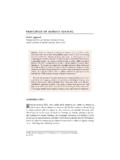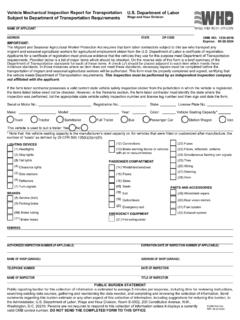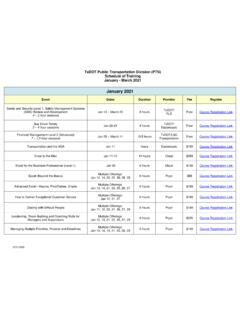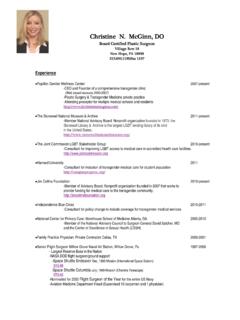Transcription of Chest Tubes - EMS | Metro Region EMS System | Saint Paul ...
1 Page 1 of 8 Chest Tubes NURS C-5 PART I: Chest DRAINAGE System (ATRIUM) DRY SUCTION PART II: INSERTION OF Chest TUBE PART III: MANAGEMENT: PATIENT AND EQUIPMENT PART IV: CHANGING THE Chest TUBE DRAINAGE DEVICE PART V: REMOVAL OF Chest TUBE PURPOSE: 1. To identify the nursing responsibilities for the setup and collection of air and fluid to restore the Chest to its normal condition. 2. To identify conditions that might result in request for Chest tube placement: a. Surgery, trauma, air leaks, and bleeding into the Chest (hemothorax, pneumothorax) b. Lung abcess (empyema) 3.
2 To outline registered nurse responsibilities in assisting the physician with the insertion, ongoing management, changing, and removal of a closed System drainage Chest tube. 4. If physician requests permanent Chest drainage placement, refer to Pleural/Peritoneal Drainage Catheter Care in the Home Setting Policy, and initiate RAD76 order set. POLICY STATEMENT: 1. Upon written order of the physician, a registered nurse may, with informed consent, set up the Atrium dry suction Chest drainage System . 2. Only physicians may insert, irrigate, instill medication, and remove Chest Tubes . Cardiovascular PA may also remove Chest Tubes .
3 3. Physician may request intracavitary tPA instillation through drainage System . Refer to RAD89-INTRACAVITARY TISSUE-TYPE PLASMINOGEN (TPA) VIA DRAINAGE CATHETER ORDER SET. 4. Management shall be in the hands of the RN, with specific areas being delegated to other licensed personnel. 5. Observations and assessment of Chest Tubes and suction set-ups shall occur at the beginning of each shift, and checked several times throughout the shift. 6. A licensed nurse may change the drainage System only when the collection chamber is full or tipped. RISKS Page 2 of 8 Chest Tubes NURS C-5 Although Chest tube insertion is a commonly used as a therapeutic measure, there are several complications that can develop, including: bleeding from an injured intercostal artery (running from the aorta) accidental injury to the heart, arteries, or lung resulting from the Chest tube insertion a local or generalized infection from the procedure persistent or unexplained air leaks in the tube the tube can be dislodged or inserted incorrectly insertion of Chest tube can cause open or tension pneumothorax SUPPORTIVE DATA 1.
4 Chest Tubes drain accumulated air or fluids from the pleural space thereby expanding lung tissue by re-establishing negative pressure in the intrapleural space. 2. Tubes are usually placed in the second intercostal space anteriorly to remove air, and the eighth or ninth intercostal space posteriorly to remove fluids. 3. The drainage device used at St. Luke's Hospital is the disposable Atrium dry suction (a collection chamber, a water seal chamber, and a dry suction control). a. Fluid drainage collects in the collection chamber. b. The water seal chamber prevents re-entry of air into the pleural cavity. c. The dry suction control dial controls the amount of negative pressure exerted by the drainage System .
5 PART I Chest DRAINAGE System (ATRIUM) PROCEDURE STEPS 1. Assemble equipment: a. 3600 Atrium multipurpose System located in SPD. b. Banding gun and nylon ties (available in SPD per physician request). c. Continuous wall suction. d. 72 inch connecting tubing. 2. Open package: a. Remove non-sterile plastic wrap. Page 3 of 8 Chest Tubes NURS C-5 b. Open first sterile wrap. c. Open second sterile wrap in sterile field. 3. Floor stand Swing floor stand open for System setup and secure placement on floor. Floor stand should be closed during patient transit. 4. To fill water seal chamber Sterile water vial is located on the back of each atrium unit.
6 Twist top off sterile water vial and insert tip into suction port. Squeeze contents into water seal until fluid reaches 2cm fill line. 5. Remove patient tube connector cap and connect to patient s Chest tube. Connect Chest prior to initiating suction. Make sure patient tube clamp is unclamped. 6. Apply suction: a. Connect 72 inch connecting tubing to continuous wall suction. Then connect to suction control stopcock. b. Set suction dial at ordered amount (Preset at -20 cm). Physician will usually order -20 cm suction. Turn wall suction up until bellows expands past triangle mark or beyond. 7. For optimal drainage results, place System below the patient s Chest in an upright position to avoid accidental knock-over, swing the floor stand to open or hand System bedside with the hanger provided.
7 8. Operation: a. Water seal should be maintained at 2 cm line and suction control chamber should bubble gently. b. Observe for air leaks. When bubbling is observed going from right to left in the air leak zone, this will confirm a patient air leak NOTE: The ball will normally oscillate at the bottom of the water-seal. Only bubbles indicate an air leak.. 9. Manual high negativity vent To manually lower the height of the water-seal column or patient pressure when connected to suction, temporarily depress the filtered manual vent, located on top of the drain, until the float valve releases and the water column lowers to the desired level.
8 Do not lower water-seal column when suction is not operating or when patient is on gravity drainage. 10. Sampling patient drainage Fluid samples can be taken directly from the patient tube at the needleless luer port on the patient tube connector. Alcohol swab the luer port prior to syringe attachment (no needle). 11. Disconnection: a. Clamp off all indwelling thoracic catheters prior to disconnecting tube from patient. b. Place atrium and all indwelling catheters into red disposable bag. Do not cut, disconnect or disassemble the unit and catheters prior to disposal. Place sealed red bag into large red container located in soiled utility room.
9 DOCUMENTATION 1. EMR PART II - INSERTION OF Chest TUBE EQUIPMENT 1. From SPD or floor stock in ED, ICU, Radiology: a. Drainage System as specified by the physician, such as: 1) Atrium drainage System dry suction b. Chest tube, size and type as ordered by physician Page 4 of 8 Chest Tubes NURS C-5 c. Chest Intubation tray d. Unsterile Chest tube clamps (2 for each Chest tube) e. Heimlich valve or pneumostat valve if requested by physician f. Banding gun and nylon ties (if requested by physician) 2. Continuous wall suction (except in Special Units where suction is built in). 3. From Nursing Unit: a. Rubber band b. Safety pin c.
10 4x4 gauze d. Tape as per physician preference PROCEDURE STEPS 1. Assemble equipment. 2. Explain procedure to patient and obtain informed consent. Perform a time out for procedure and document. 3. Pre-medicate per physician order and support patient during procedure. 4. Connect Chest tube to System . Turn wall suction on until bellows past mark. Atrium is pre-set at -20 mmHg. Bellows must expand to arrow for suction at -20cm. 5. After procedure is complete (these are done immediately after procedure is completed in order to have a baseline for comparison): a. Check System for proper functioning. b. Secure all connections with tape or banding gun per physician request.







